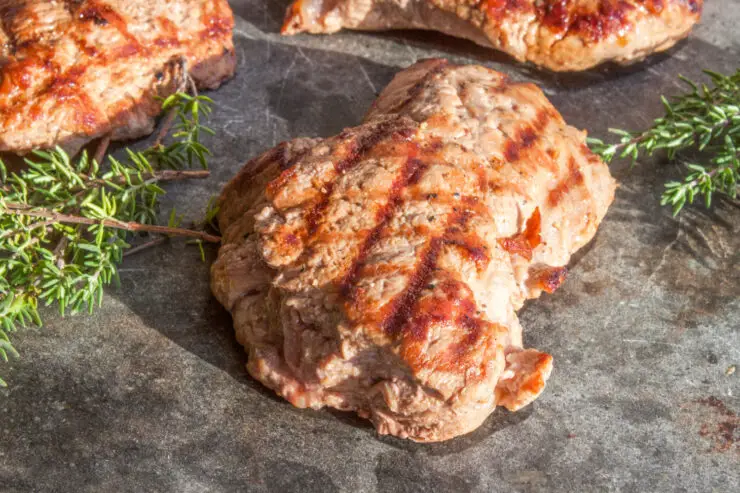As an Amazon Associate I earn from qualifying purchases. Please read the disclaimer for more info.
So, what does Moose taste like? Are you curious about tasting moose meat but not quite sure whether you will like it?
Have no fear! Moose meat is becoming increasingly popular and widely accessible – it’s a great source of lean protein with an incredibly mild and versatile flavor.
It’s also relatively easy to cook with if you know the basics.
In this blog post, we’ll shed some light on everything from the unique taste of moose meat to where to buy it and how to prepare it for optimal deliciousness.
So read on – get ready to explore a true wild treat!
Key Takeaways
- Moose meat has a flavor similar to beef but is often described as having a slightly gamier taste.
- Moose is best cooked low and slow as it is low in fat and becomes tough when cooked on high heat.
- When buying moose, look for cuts with even marbling throughout – these will be the most tender and flavorful.
What is Moose?
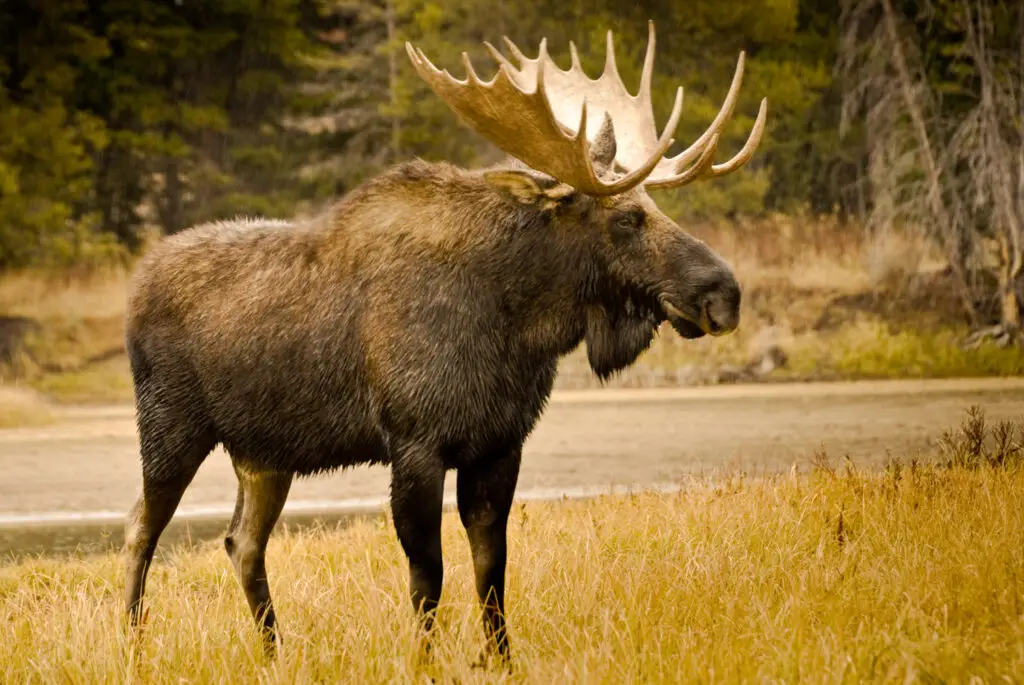
A moose, scientifically known as Alces alces, is the deer family’s largest and heaviest extant species. Characterized by their massive size, long legs, and pendulous muzzle, males are instantly recognizable by their enormous antlers, which can spread 6 feet from end to end.
Moose primarily inhabit areas that have cold, snowy winters and stand six feet tall from hoof to shoulder, weighing in at more than 1,000 pounds.
Moose are herbivores, grazing from dawn to dusk. Their diet includes leaves, twigs of woody plants, willow, aspen, birch, maple, and pin cherry.
They eat up to 70 pounds of vegetation per day.
Can You Eat Moose Meat?
As for consumption, yes, moose meat can be eaten, and its meat, often referred to as moose steak, is quite popular in certain cultures.
Moose meat is derived from wild shot moose.
Moose meat has a flavor similar to beef but is often described as having a slightly gamier taste. It’s lean, high in protein, and low in fat.
There are various ways to prepare moose meat. It can be roasted, stewed, grilled, or ground up for burgers or sausages.
As with other wild game meats, marinating the meat can help to tenderize it and enhance its flavor. However, due to its low fat content, care must be taken to prevent it from drying out during cooking.
Hunting Moose
Hunting moose requires knowledge of their behavior and habitat and adherence to local hunting regulations. Safety is paramount, given the size and strength of these animals. Moose are generally peaceful but can be aggressive when threatened or during mating season.
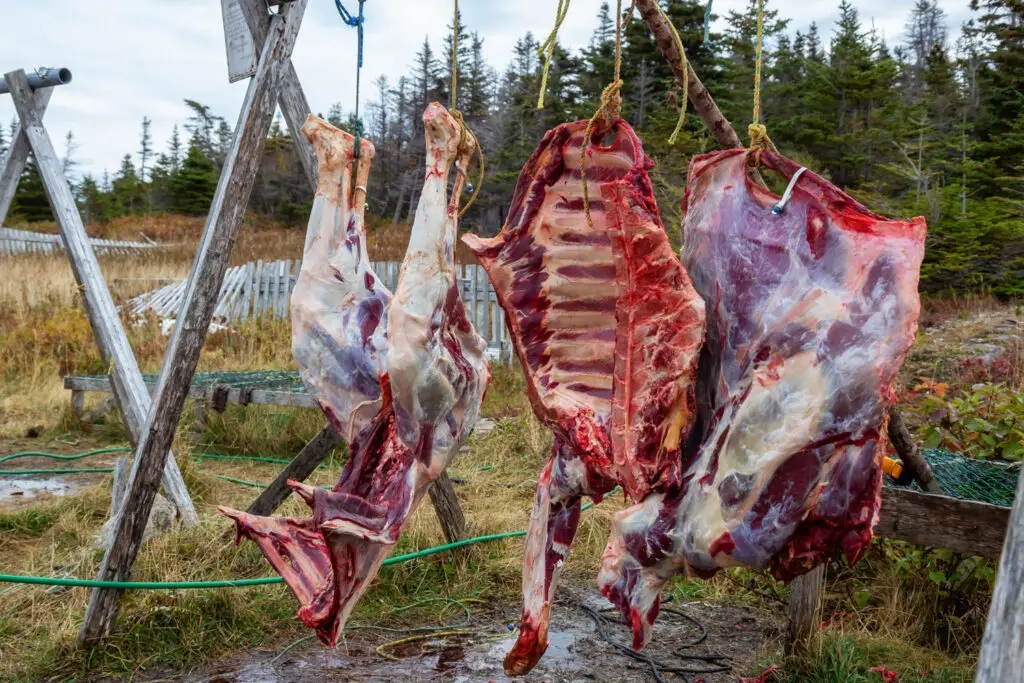
Handling Moose Meat
When it comes to handling and cooking moose meat, basic food safety rules apply. As with other wild meat, it should be properly cleaned, stored at the right temperature to prevent bacterial growth, and cooked to an internal temperature of at least 165°F (74°C) to ensure any potential pathogens are killed.
Elk meat is sometimes labeled as Moose meat. While they are similar animals in appearance, their habitat and lifestyle result in a different tasting meat.
Related: Can You Eat Starfish?
What does Moose Taste Like? What is the Texture?
The Moose meat taste is unlike any other game meat. It’s lean, high in protein, and low in fat. While it shares some similarities with beef, moose has its distinctive characteristics that set it apart.
The flavor is robust, slightly sweet, and often described as having a hint of gaminess that echoes the wild landscapes where these wild game meat creatures roam.
The texture of moose meat can vary depending on the cut and how it’s prepared. It can range from tender and juicy when slow-cooked or braised to firm and chewy when grilled or pan-fried.
Due to its low-fat content, moose meat can easily become tough if overcooked. Therefore, a careful cooking approach is needed to ensure the meat remains moist and flavorful.
How to Cook Moose Meat
Cooking moose meat can be an exciting culinary adventure for the seasoned chef or adventurous home cook. Due to its distinct flavor and texture, this game meat offers a unique dining experience that is both delicious and nutritious.
Because it is a very lean meat, moose meat tastes best when cooked slow and low.
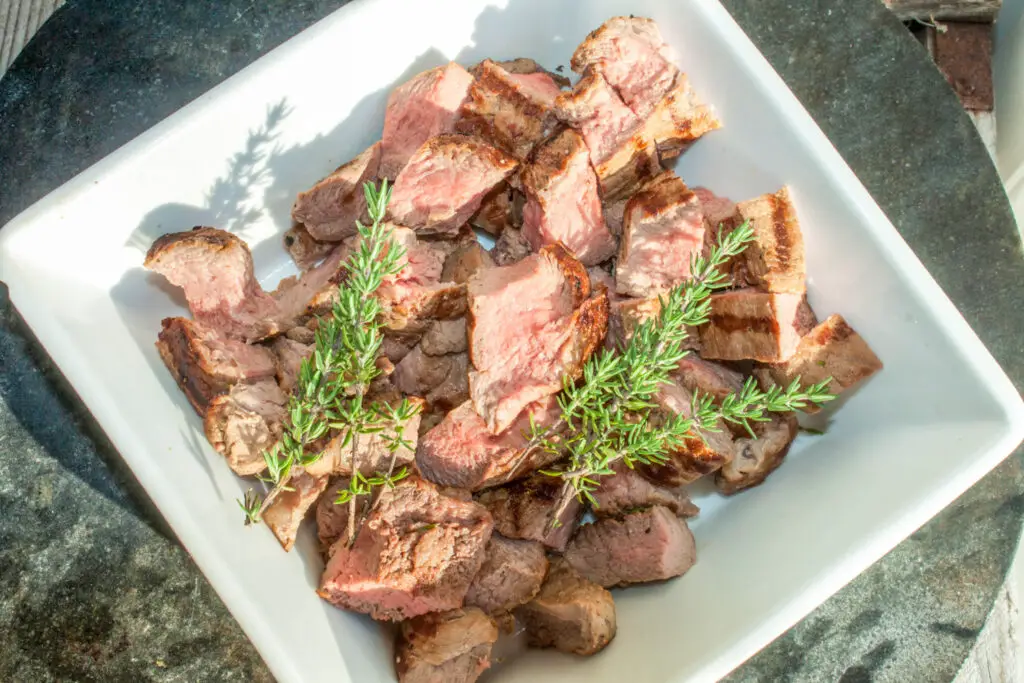
Understanding Moose Meat Cuts
Like other large mammals, a moose yields several types of cuts, each suited to different cooking methods:
- Tenderloin and backstrap are the most tender cuts of moose meat. They’re best suited for quick cooking methods like grilling or pan-searing.
- Roasts, including rump, shoulder, and neck roasts, are perfect for slow-cooking methods to break down the tougher muscle fibers and connective tissue.
- Stew Meat and Ground Meat come from various parts of the moose and are ideal for slow-cooked dishes like stews, chili, or burgers.
Preparation Methods
Marinating
Marinating moose meat not only adds flavor but also helps tenderize it. A simple marinade could include olive oil, red wine, garlic, herbs, and spices. Marinate for at least 4 hours, or overnight for the best results.
Grilling
Grill tender cuts of moose, such as steaks, over high heat for a short period. As a general guide, grill steaks for 4-6 minutes per side until they reach an internal temperature of 145°F (medium-rare)
Roasting
Roast larger cuts at a low temperature (325°F) in the oven. A 3-pound roast should cook for about 2-3 hours until it reaches an internal temperature of 160°F[^2^].
Smoking
Smoking imparts a unique flavor to the meat. Smoke a moose roast at 225°F for 4-5 hours or until the internal temperature reaches 165°F.
Related: Can You Eat Stingray?
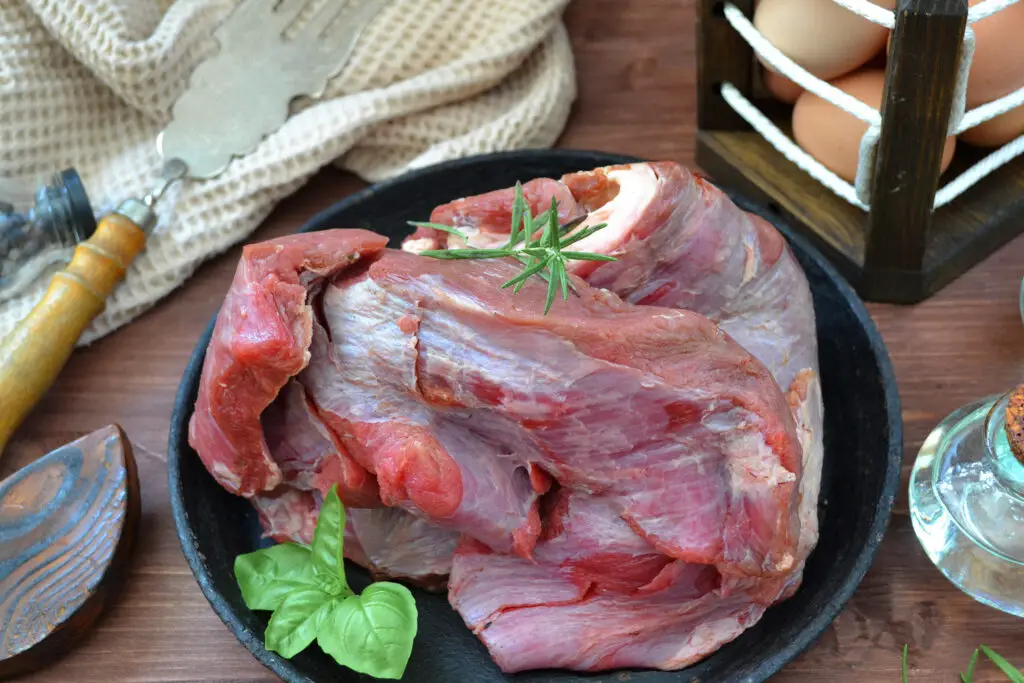
Recipes
Moose Meat Chili
This chili recipe is an ultimate comfort food showcasing ground moose meat’s rich flavor.
- Brown 1lb of ground moose meat with 1 chopped onion and 2 minced garlic cloves.
- Add 1 can of diced tomatoes, 1 can of kidney beans, 2 tbsp chili powder, and salt and pepper to taste.
- Simmer for 1 hour, stirring occasionally. Serve with warm cornbread.
Grilled Moose Steak
This simple recipe lets the natural flavor of the moose steak shine.
- Marinate a moose steak in a mixture of olive oil, garlic, rosemary, and black pepper for at least 4 hours.
- Preheat your grill to high heat. Grill the steak for 4-6 minutes per side.
- Let the steak rest for 10 minutes before slicing against the grain.
Roasted Moose Rump Roast with Root Vegetables
A hearty main dish perfect for special occasions or family dinners.
- Season a 3lb moose rump roast with salt, pepper, and your favorite herbs.
- Place the roast in a roasting pan surrounded by chopped root vegetables like carrots, parsnips, and potatoes.
- Roast at 325°F for about 2-3 hours or until the internal temperature reaches 160°F.
- Let the roast rest for 15 minutes before slicing.
Cooking moose meat can be a rewarding culinary experience. Whether you’re a seasoned chef or a home cook, these recipes offer a great starting point for exploring this unique ingredient.
Looking for more recipes? Try out this cookbook – love the name!
Buck, Buck, Moose: Recipes and Techniques for Cooking Deer, Elk, Moose, Antelope and Other Antlered Things
What to Drink While Eating Moose Meat
Moose meat, with its rich and slightly gamey flavor, can be paired with a variety of beverages to enhance the overall dining experience. Whether you’re preparing a tender moose steak or a hearty moose stew, the right drink can elevate your meal to new heights.
1. Red Wine
A full-bodied red wine such as a Cabernet Sauvignon or Syrah pairs well with game meats like moose. These wines have robust flavors that can stand up to the rich taste of the meat. The tannins in red wine can help cut through the fat and balance the flavors.
2. Craft Beer
A dark, malty beer like a stout or porter can complement the strong flavors of moose meat. The beer’s sweetness can help balance the gamey taste, while its carbonation can cleanse the palate.
3. Whiskey
If you’re serving a grilled moose steak, consider pairing it with a smoky whiskey. The charred flavors from the grill can echo the peaty notes in the whiskey, creating a harmonious pairing.
4. Non-Alcoholic Pairings
Consider a tart cranberry juice or a rich, dark cherry juice for non-alcoholic options. These beverages offer a nice contrast to the savory flavors of the meat. Sparkling water infused with citrus can also be a refreshing choice when eating wild game meat.
Related: Fish Eyes: Can You Eat Them?
Moose Meat Nutrition
Moose meat is a highly nutritious choice for those seeking a lean, protein-rich source of red meat.
A 3-ounce serving of cooked, roasted moose meat contains approximately 114 calories, an impressive 87% of which comes from protein.
This game meat is also low in fat, with just 7% of its total caloric content derived from this macronutrient.
In addition to being a great source of protein, moose meat is packed with essential vitamins and minerals. It’s an excellent source of B vitamins, specifically niacin and riboflavin, which are critical for energy metabolism.
Moose meat also provides a significant amount of iron, a mineral essential for oxygen transport in the blood.
Interestingly, moose meat has a unique fatty acid profile compared to other big game, further enhancing its nutritional value.
Are There Any Risks Associated with Eating Moose Meat?
While moose meat is generally safe and highly nutritious, some potential risks are associated with its consumption.
Certain contaminants may be present in higher levels in the liver and kidneys of moose, so it’s recommended to consume these organs only occasionally and in moderate amounts.
The meat can also carry parasites like Toxoplasma gondii, which can cause a disease called Toxoplasmosis if the meat is consumed raw or undercooked.
As always, proper handling and thorough cooking of game meat are essential to minimize any potential risks.
Related: Eating Guinea Pig in Peru
Where to Buy Moose Meat?
Wild Moose meat can be purchased from specialty butchers and some larger supermarkets. It’s also available online from various vendors, so getting your hands on this delicious game meat is easy.
When buying moose meat online, ensure you’re dealing with a reputable vendor following proper food safety protocols. This will ensure that the meat is fresh and free from contaminants.
When purchasing moose meat at a local butcher, make sure it’s been properly handled and stored at the right temperature. The USDA recommends eating game meat within two days of purchase.
Final Thoughts
Moose meat is a delicious and highly nutritious source of protein that can be enjoyed in many dishes. With proper preparation, it can add great flavor to any meal.
Whether you’re smoking, grilling, or roasting moose meat, the right pairing of beverages can bring out its unique characteristics even more.
Finally, while moose meat has a rich nutritional profile, proper handling, and cooking techniques are important to minimize potential risks.
FAQ
What is the difference between venison meat and moose meat?
Moose meat is slightly darker in color and has a more pronounced gamey flavor than venison or deer meat. Moose meat also contains higher fat levels, making it more tender when cooked. Conversely, Venison is typically leaner than moose meat and can be tougher in texture if not cooked properly.
Did you find this post useful? Then you might be interested in one of these:

